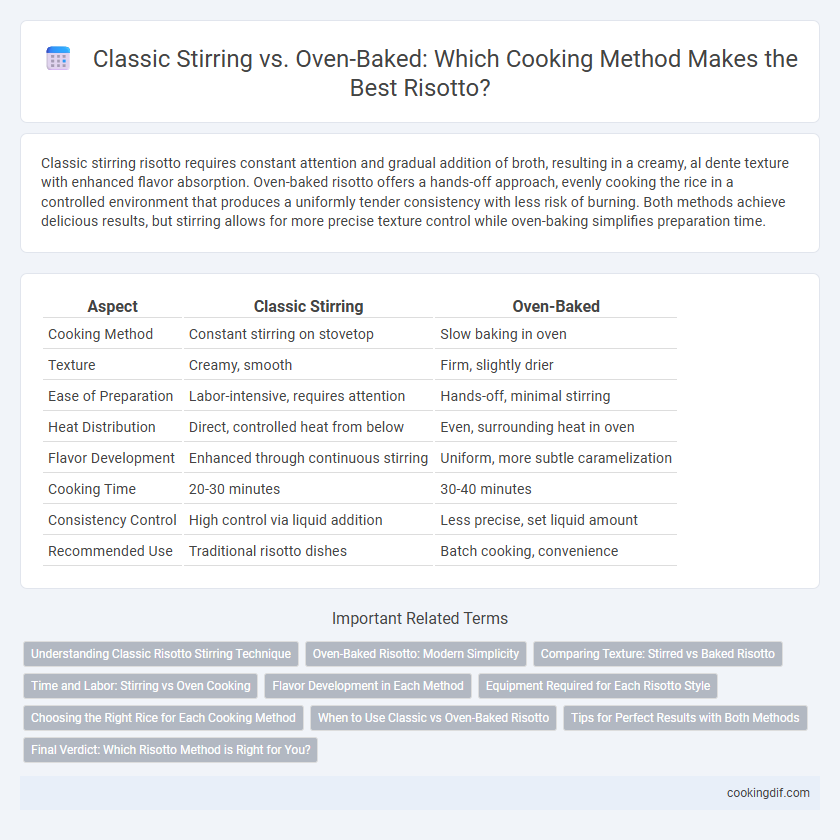Classic stirring risotto requires constant attention and gradual addition of broth, resulting in a creamy, al dente texture with enhanced flavor absorption. Oven-baked risotto offers a hands-off approach, evenly cooking the rice in a controlled environment that produces a uniformly tender consistency with less risk of burning. Both methods achieve delicious results, but stirring allows for more precise texture control while oven-baking simplifies preparation time.
Table of Comparison
| Aspect | Classic Stirring | Oven-Baked |
|---|---|---|
| Cooking Method | Constant stirring on stovetop | Slow baking in oven |
| Texture | Creamy, smooth | Firm, slightly drier |
| Ease of Preparation | Labor-intensive, requires attention | Hands-off, minimal stirring |
| Heat Distribution | Direct, controlled heat from below | Even, surrounding heat in oven |
| Flavor Development | Enhanced through continuous stirring | Uniform, more subtle caramelization |
| Cooking Time | 20-30 minutes | 30-40 minutes |
| Consistency Control | High control via liquid addition | Less precise, set liquid amount |
| Recommended Use | Traditional risotto dishes | Batch cooking, convenience |
Understanding Classic Risotto Stirring Technique
Classic risotto relies on the traditional stirring technique, where constant, gentle stirring releases the starches from Arborio or Carnaroli rice, creating a creamy texture essential to authentic Italian risotto. This method allows gradual absorption of hot broth, enhancing flavor infusion and achieving a perfectly al dente consistency. Oven-baked risotto, while requiring less attention, lacks the delicate creaminess and precise texture control that the classic stirring technique delivers.
Oven-Baked Risotto: Modern Simplicity
Oven-baked risotto offers modern simplicity by requiring less constant stirring compared to classic stovetop methods, allowing even heat distribution for perfectly cooked rice. This method utilizes a single, covered dish in the oven, enhancing the absorption of broth and flavors while freeing time for multitasking in the kitchen. Oven-baked risotto achieves creamy texture with minimal effort, making it an efficient alternative that maintains the authentic taste of traditional risotto.
Comparing Texture: Stirred vs Baked Risotto
Stirring risotto constantly during cooking results in a creamy, velvety texture due to the gradual release of starch from the Arborio rice. Oven-baked risotto, by contrast, produces a firmer, slightly drier consistency with more distinct grains, as the rice cooks evenly without constant agitation. The choice between stirred and baked methods affects both mouthfeel and moisture content, catering to different textural preferences.
Time and Labor: Stirring vs Oven Cooking
Classic stirring risotto demands constant attention and vigorous stirring for 18 to 20 minutes to achieve its creamy texture, making it a labor-intensive process. Oven-baked risotto requires significantly less active labor, as it cooks evenly in about 25 to 30 minutes with minimal stirring, freeing up time for other tasks. Choosing between methods depends on balancing hands-on cooking time against overall convenience and desired texture.
Flavor Development in Each Method
Classic stirring allows gradual absorption of broth, promoting creamy texture and releasing starch that enriches risotto's flavor complexity. Oven-baked risotto offers even heat distribution, intensifying caramelization and producing a nuttier, more concentrated taste. Both methods develop distinct flavor profiles by manipulating heat and moisture during cooking.
Equipment Required for Each Risotto Style
Classic stirring risotto requires a heavy-bottomed saucepan or skillet and a wooden spoon or spatula for continuous stirring, along with a ladle for gradually adding broth. Oven-baked risotto needs an ovenproof dish or Dutch oven that evenly distributes heat and a tight-fitting lid to retain moisture during the baking process. Both methods benefit from a heat source like a stovetop or oven and access to warm broth.
Choosing the Right Rice for Each Cooking Method
Arborio rice is ideal for classic stirring methods due to its high amylopectin content, which releases creamy starch when continuously agitated. For oven-baked risotto, Carnaroli rice is preferred because its firmer texture and larger grain size maintain structure without becoming mushy during longer, even heat exposure. Selecting the right rice enhances the texture and creaminess suited to each cooking technique, achieving authentic risotto results.
When to Use Classic vs Oven-Baked Risotto
Classic stirring risotto is ideal for achieving a creamy texture and precise control over doneness, especially when cooking Arborio or Carnaroli rice varieties. Oven-baked risotto offers a hands-off approach suitable for large batches or when multitasking, maintaining even cooking with less frequent stirring. Choose classic stirring for traditional, restaurant-quality results and oven-baked risotto for convenience and consistent moisture retention.
Tips for Perfect Results with Both Methods
For classic stirring, maintain medium heat and gradually add warm broth while continuously stirring to release the rice's starches, ensuring a creamy texture. Oven-baked risotto benefits from preheated broth and a tight-fitting lid to evenly cook the rice without constant attention, reducing the risk of burning. Both methods require finishing with butter and Parmesan cheese off heat to enhance richness and achieve the perfect al dente consistency.
Final Verdict: Which Risotto Method is Right for You?
Classic stirring risotto offers precise control over texture and creaminess by gradually releasing starch through continuous stirring, ideal for culinary enthusiasts seeking traditional authenticity. Oven-baked risotto simplifies the process, providing consistent results with less hands-on time, making it perfect for busy home cooks or those new to risotto preparation. Your choice depends on whether you prioritize the interactive cooking experience and nuanced control of classic methods or the convenience and reliability of oven-baking techniques.
Classic stirring vs Oven-baked for cooking method Infographic

 cookingdif.com
cookingdif.com